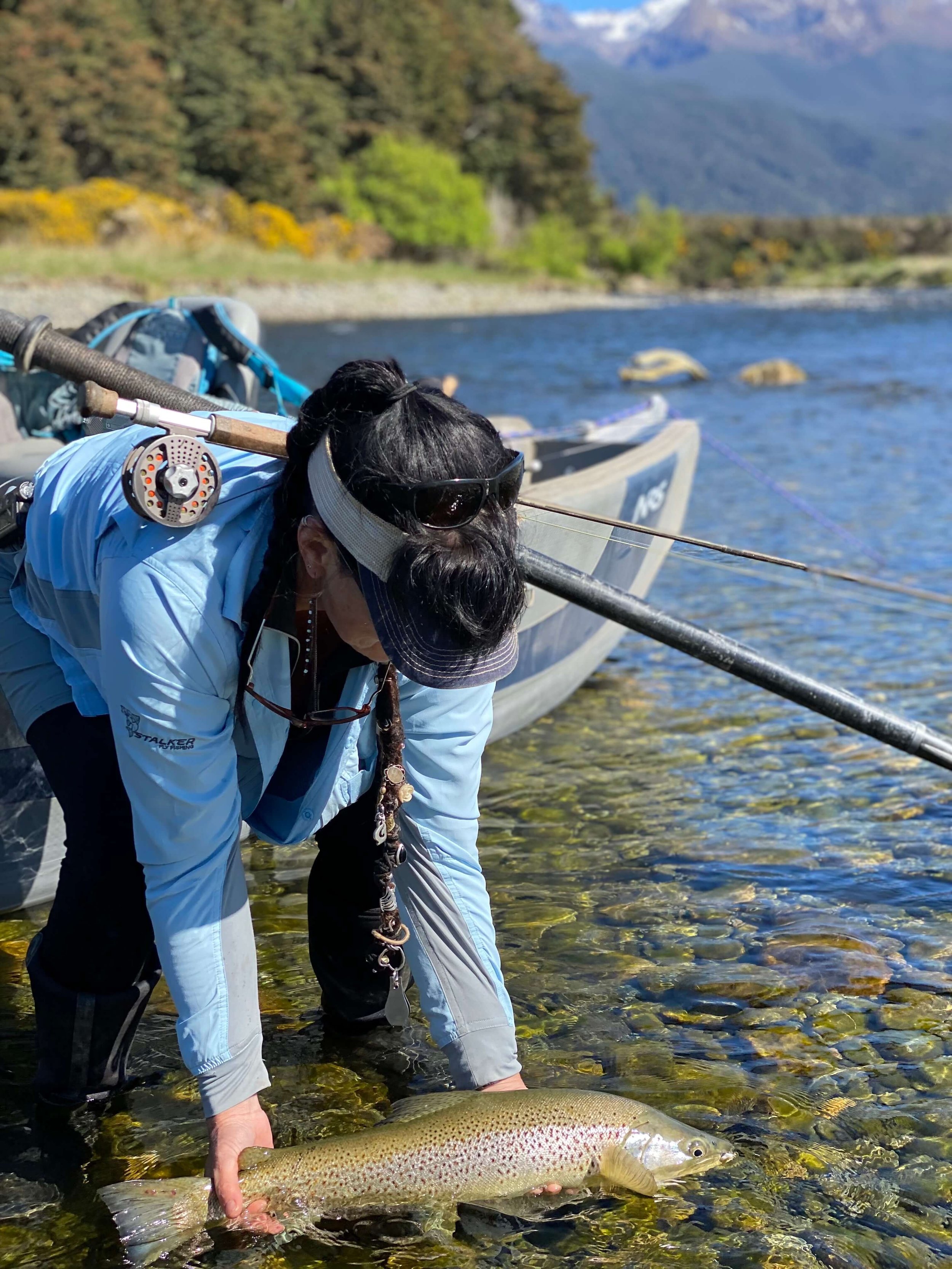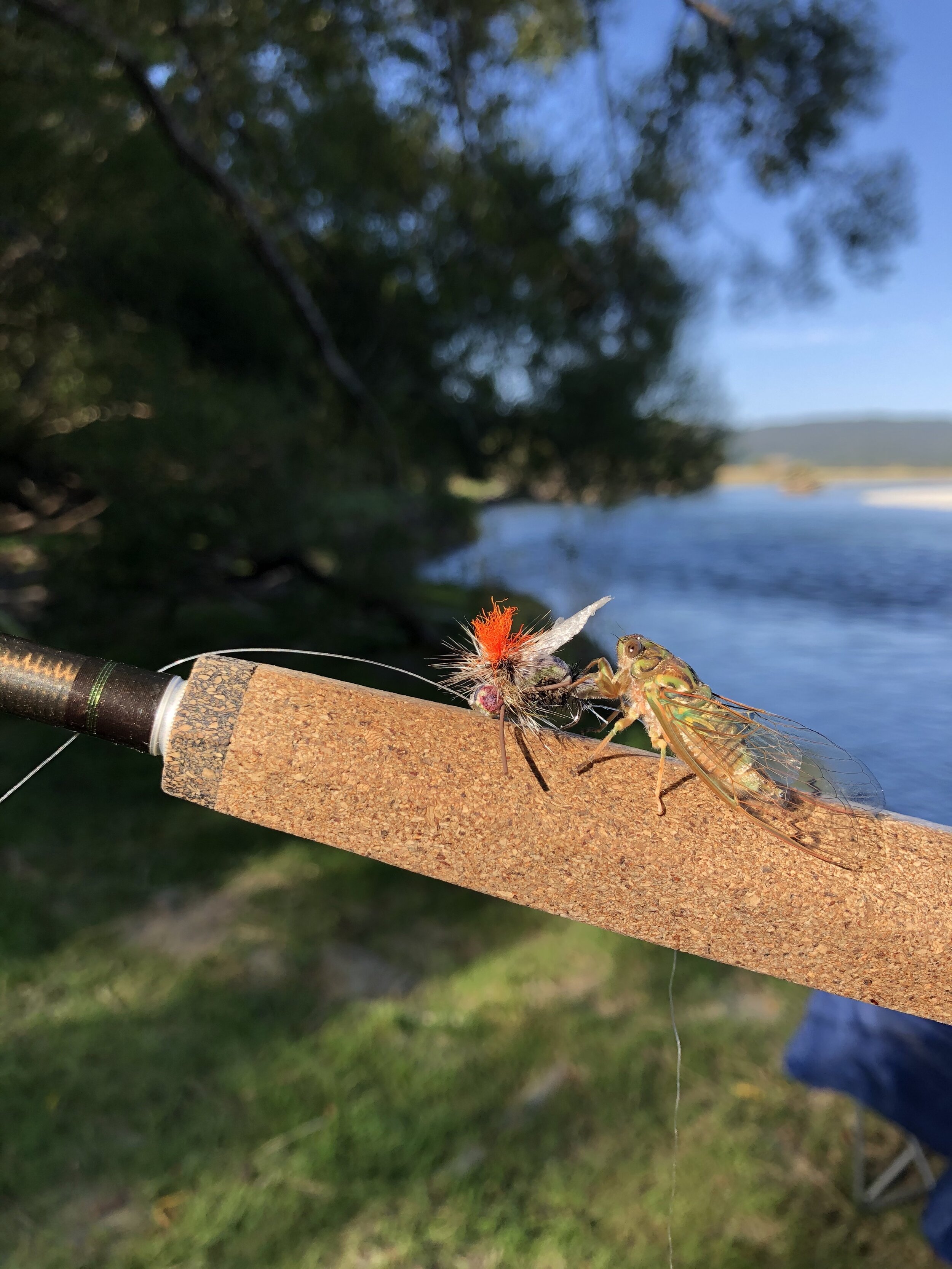
Fishing by the Seasons
October
October signals the start of the trout fishing season across most of Southland. Some of Fiordland’s eastern tributaries remain closed to fishing until the following month, but essentially its game on across the majority of the region. Rainfall and snow melt keep flows high in many of the larger rivers however, the smaller streams come into their own this time of year.
The start of the season offers a rare opportunity to target large fish in some surprisingly small streams less than a rod length across. After winter, many large trout will remain in small spawning tributaries until the low flows of summer displace them downstream to the sanctuary of larger river systems.
Fish are primarily focussed on subsurface feeding early in the season, so we fish heavy nymphs a lot, as many fish remain close to the bottom until the water temps start to get above 10°C. We do still experience some small stonefly and mayfly hatches to spice up the day with rising fish.
The annual whitebait and smelt run is in full swing in the lower reaches of the main river systems, which offers some exciting fishing to marauding sea trout throughout the spring months.
November
Early season is the time to chase big fish due to healthy stream flows and a lack of angling pressure. The last of the snowmelt from the mountains usually occurs during this month, affecting some streams, though there’s always myriad reliable fishing locales. The tributaries of lakes Te Anau and Manapouri open to fishing this month as wildflowers bloom along the region’s riverbanks. These streams are home to brown and rainbow trout that have not seen an angler in 5 months!
Nymph fishing is still the most reliable method, though when the fish are looking up, we fish dry/dropper rigs or mayfly emerger, dun and spinner patterns. Hatches occur during the middle of the day, especially our dominant mayflies (Deleatidium and Coloburiscus sp.). The emergence of the brown beetle (Costelytra Zealandica) commences in November and goes through to Christmas. Although the beetles are most active during warmer nights, the trout in our lowland streams will still take a well presented imitation confidently during daylight hours.
December
December is a transitional month for fishing and insect life. Rivers are starting to drop and the water temperatures approach the “sweet spot” for feeding fish. Trout that have held over in small tributary streams post-spawning drop downstream into the larger systems. Daytime hatches of mayflies and caddis start to shift to evenings.
As the busy Christmas and New Years’ holiday period approaches, terrestrial life starts to play a dominant role in the trout’s diet. Brown Beetles, Manuka Beetles (Pyronota Festiva), Willow Grubs (Nematus Oligospilus) and blowflies become important food items to imitate as we move into the summer months.
December is a diverse month in terms of fishing with a regular mix of dry fly and nymph fishing. Most fish have dropped out of the small tributaries increasing the fish density in the main river channels. It is easy to see why this is one of our favourite months for float trips on our home river.
January
Terrestrials become the main quarry during the height of summer. Blowflies, beetles and cicadas are prevalent in Fiordland and Southland. Lesser known terrestrials like Robber Flies, Hawthorn Flies, spiders, and wasps may also be on the menu. The terrestrial bite in the backcountry streams and Waiau River can provide exciting dry fly fishing in January.
Most lowland streams with bank-side willows will have a steady fall of Willow Grubs that can transfix the resident brown trout underneath the overhanging willow branches. Willow grubbing fish can present a frustrating but exciting form of sight fishing; “Grubbers” will often become enamoured with the tiny yellow or olive (#20) grubs falling onto the water and a perfect presentation into tight cover is frequently necessary to fool them.
February
Cicada activity peaks during the warmest parts of the day and their song can be deafening along the margins of many of our lakes, rivers and streams. Rivers can be low in February with considerable angling pressure though big trout will move a long way to eat a cicada during the middle of the day.
Cicadas proliferate wherever bank side native bush or tussocks are present. There are several important species to the fly fisher in our area, ranging in size from the large (#10-6) colourful Chorus Cicada (Amphipsalta Zelandica) down to smaller (#12-14) less conspicuous species in the Maoricicada and Kikihia genus. Colours vary from single or combinations of olive, lime/bright green, brown, grey, black and tan, so it’s important to have a variety of patterns on hand during cicada time.
March
March is another transitional month in terms of trout food and weather. Cicadas, willow grubs and blowflies are the main trout quarry during the day if the weather stays warm. Caddis and mayfly hatches occur at dusk though the daytime Deleatiduium mayfly hatches and spinner falls start up again once the morning frosts arrive and the days cool down.
It can be a tough month for fishing if the rivers are low, warm and have experienced regular angling pressure during the peak summer season. Trout food is often scarce until rainfall brings a good fresh and rejuvenates the rivers. Matching the hatch and fishing light tippet on long leaders is a prerequisite for success this time of year.
April
Mayfly time!
A lot of our fishing centres on the productive lowland rivers and streams during April, where mayfly hatches dominate. The willow leaves turn golden yellow and begin to fall as Southland’s brown trout start to show their nuptial colours in preparation for spawning.
Deleatidium mayfly hatches occur most days especially during cold, drizzly weather with a slight upstream breeze. Spinner falls might occur anytime of day when conditions are calm. Most days start out with fishing mayfly nymphs in riffles and drop offs, until the duns start to emerge or spinners start to fall and it’s time to switch up to dry flies.
May
The Waiau and many of Fiordland’s tributaries are open until the end of May; however, the majority of Southland’s rivers and streams close to fishing after April 30th. The brown trout spawning migration is in full swing with rainbows hot on their heels to capitalise on the egg feast. Fishing the days following a pulse of high water can produce great fishing, often in very shallow water. You never know what you might come across as each water bump brings a new push of migrating fish!
Trout shift their interest back towards subsurface feeding on mayfly nymphs, caddis grubs and eggs but Deleatidium mayfly duns will continue to hatch well into June, if the weather conditions are right. These sporadic hatches happen during the warmest part of the day and can provide a welcome dry fly surprise to mix up the nymphing and streamer fishing.
June & July
Winter is well and truly here with the majority of our rivers and streams being closed to fishing until October. All of our lakes remain open year round, along with the coastal reaches of our main rivers. Some of Fiordland’s remote streams remain open but require aircraft access.
The lower reaches of the largest Southland rivers can provide fun fishing between high water events. Significant rainfall in early winter inundates lake margins and provides opportunities to target tailing trout enticed into shallow water to eat drowned spiders, earthworms and terrestrial larva.
We tend to fish the coastal rivers when it’s dry and then hit the lakes when it’s wet, making the most of the short winter days. The temperatures are cold, so you have to rug up and dress to the conditions.
August & September
August cues the annual whitebait and smelt migrations along our coastal rivers. The term Whitebait collectively describes the juvenile phase of 5 native Galaxias species. Whitebait shoals migrate upstream from the ocean and provide a highly sought after quarry for trout, birds and a passionate demographic of kiwi harvesters known as “Whitebaiters”. Whitebaiters congregate along the banks of Southland’s estuaries and river mouths during the whitebait harvest season, which runs from September through to the end of October. This kiwi tradition is quite a sight for the uninitiated.
Close behind the whitebait are native smelt (Retropinna Retropinna), which provide an additional high protein prey item. Migrating whitebait and smelt provide an extraordinary feeding opportunity for trout and in turn, can produce some exciting fishing for anglers targeting the coastal areas during late winter and spring.




















